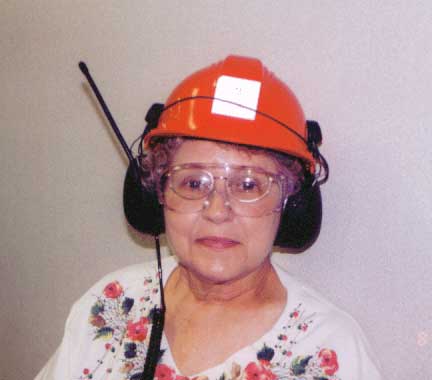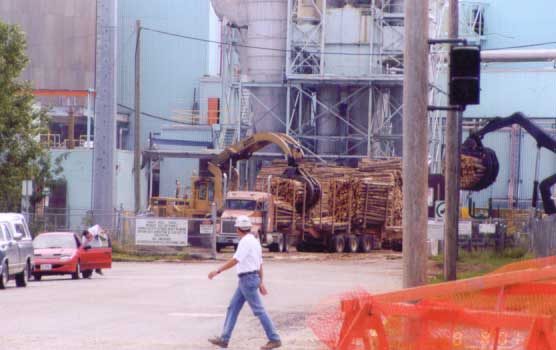Abitibi Paper Mill
We toured the Abitibi Paper Mill on Wednesday, 8
August 2001. We had planned to tour the very large Boise Cascade paper mill in
International Falls, MN, but their tours were suspended until the following week
because they were making changes to one of their paper production lines. The
Boise Cascade tour guide happened along as I was inquiring about tours and
suggested that if we hurried, we could make to afternoon tour of the Abitibi
mill just across the border in Canada. We did hurry, and just made the 1:30
tour. Cameras and sandals are not permitted on the tour. However, they did allow
pictures to be made as we dressed for the tour, and pictures from outside the
plant could be made after the tour.
 |
The tour starts with an introduction of everyone, and an
explanation of what the tour shows. Hard hats and ear protectors are
required. The ear protectors include a radio receiver that allows the tour
guide to describe what is being seen, and to give instructions. Questions
are asked by using the guides radio transmitter. |
| The hard hats and ear protectors are not the most beautiful
objects, but they are very effective. The ear protectors essentially block
all sound except from the radio receiver. Paper mills are very noisy
places and hearing damage is likely if the ear protection is not worn. |
 |
 |
Logs are brought into the mill at the west end building with
large mechanical grabbers. Inside, they are first debarked and then ground
into a thin slurry called pulp with lots of water. Most is bleached to produce white
paper. The slurry is stored until needed. Additives such as clay may be
added to produce a slick finish paper. |
| The slurry is piped from the storage tanks to the building
that converts the slurry into paper. Most of this process cannot be seen
since it occurs inside a closed machine. The process is that the slurry is
spread in a thin layer on a wide conveyer belt, and then squeezed between
a series of steel rollers and dried. Steam is used to heat and dry the
slurry. |
 |
As paper mills go, this is a small mill, but it still requires a lot of
space. There are three major buildings that occupy a space equal to about two
city blocks. They have three production lines, with two operating during our
tour. The Boise Cascade mill is reported as having seven production lines. The
paper produced by each line is first gathered into rolls that are 12 feet
wide and 5 feet in diameter. These large rolls are unrolled, cut to
desired widths, and rolled again into whatever size roll is ordered for
delivery. This cutting process was really the only part of the tour that could
be easily seen, but we just missed it since they had just finished and were
carting the rolls of finished paper off to shipping.
Return to 2001 tour.
Return to Lewie's Travel Web.




